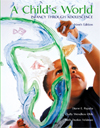 |
1 |  | 
School-age children have trouble recognizing apparently contradictory aspects of themselves. |
|  | A) | True |
|  | B) | False |
 |
 |
2 |  | 
When 8- to 12-year-old children evaluate themselves, they give the most importance to physical appearance. |
|  | A) | True |
|  | B) | False |
 |
 |
3 |  | 
According to some research, school-age children spend only about half an hour a day interacting with their parents. |
|  | A) | True |
|  | B) | False |
 |
 |
4 |  | 
As children become preadolescents, the quality of family problem solving improves. |
|  | A) | True |
|  | B) | False |
 |
 |
5 |  | 
Parents' approach to child rearing generally changes as children grow older. |
|  | A) | True |
|  | B) | False |
 |
 |
6 |  | 
Children tend to be adversely affected by their mothers' employment. |
|  | A) | True |
|  | B) | False |
 |
 |
7 |  | 
Self-care children generally live with poor single parents in urban neighborhoods. |
|  | A) | True |
|  | B) | False |
 |
 |
8 |  | 
Husbands of working mothers tend to be more involved in housework and child care than husbands of at-home mothers. |
|  | A) | True |
|  | B) | False |
 |
 |
9 |  | 
Children tend to do better in intact families. |
|  | A) | True |
|  | B) | False |
 |
 |
10 |  | 
Children often blame themselves for their parents' divorce. |
|  | A) | True |
|  | B) | False |
 |
 |
11 |  | 
The final task children face, in their adjustment to divorce, is accepting its permanence. |
|  | A) | True |
|  | B) | False |
 |
 |
12 |  | 
Children whose parents have joint custody generally adjust to divorce better than those who are in sole custody of one parent. |
|  | A) | True |
|  | B) | False |
 |
 |
13 |  | 
During the 1980s, the number of father-only families grew three times as fast as the number of mother-only families. |
|  | A) | True |
|  | B) | False |
 |
 |
14 |  | 
Boys tend to have more trouble than girls in accepting a stepfather. |
|  | A) | True |
|  | B) | False |
 |
 |
15 |  | 
Younger siblings tend to be good at sensing other people's needs. |
|  | A) | True |
|  | B) | False |
 |
 |
16 |  | 
Elder siblings more regularly take care of younger ones in nonindustrialized than in industrialized societies. |
|  | A) | True |
|  | B) | False |
 |
 |
17 |  | 
A study of school-age children in Montreal found that ethnic prejudice increases with age. |
|  | A) | True |
|  | B) | False |
 |
 |
18 |  | 
In China, sensitive, shy children tend to be unpopular during middle childhood. |
|  | A) | True |
|  | B) | False |
 |
 |
19 |  | 
During middle childhood, friends disagree more than children who are not friends. |
|  | A) | True |
|  | B) | False |
 |
 |
20 |  | 
Children who are victims of bullies often continue to be victimized even when they have different classmates. |
|  | A) | True |
|  | B) | False |
 |
 |
21 |  | 
A child who exhibits school phobia should be allowed to stay home until the phobia subsides. |
|  | A) | True |
|  | B) | False |
 |
 |
22 |  | 
Ten-year-olds frequently make up stories about their exploits and lie to avoid punishment. |
|  | A) | True |
|  | B) | False |
 |
 |
23 |  | 
In family therapy, the child whose problem causes the family to seek treatment is sometimes the healthiest member. |
|  | A) | True |
|  | B) | False |
 |
 |
24 |  | 
Drug therapy is treatment for drug addiction. |
|  | A) | True |
|  | B) | False |
 |
 |
25 |  | 
Therapy for specific problems tends to be more effective than therapy aimed at improving social adjustment in general. |
|  | A) | True |
|  | B) | False |
 |
 |
26 |  | 
Children generally take frequent moves in stride. |
|  | A) | True |
|  | B) | False |
 |
 |
27 |  | 
School is a source of worry for many children. |
|  | A) | True |
|  | B) | False |
 |
 |
28 |  | 
Resilient children are likely to have at least one close relationship with a competent, caring adult. |
|  | A) | True |
|  | B) | False |
 |



 2002 McGraw-Hill Higher Education
2002 McGraw-Hill Higher Education